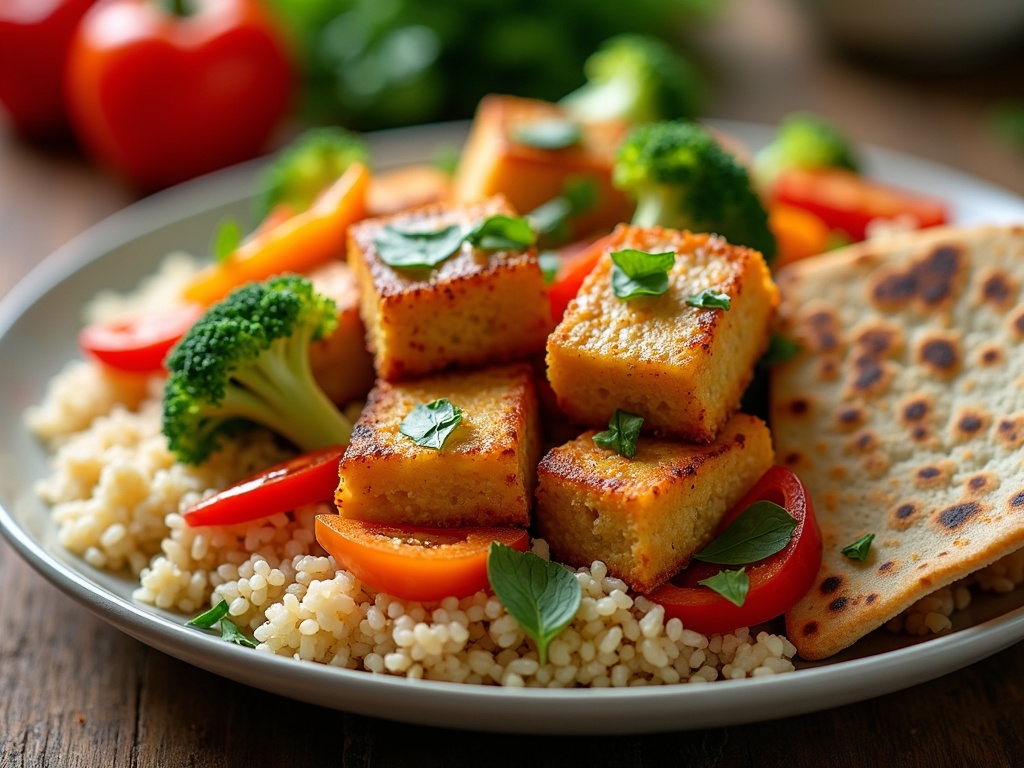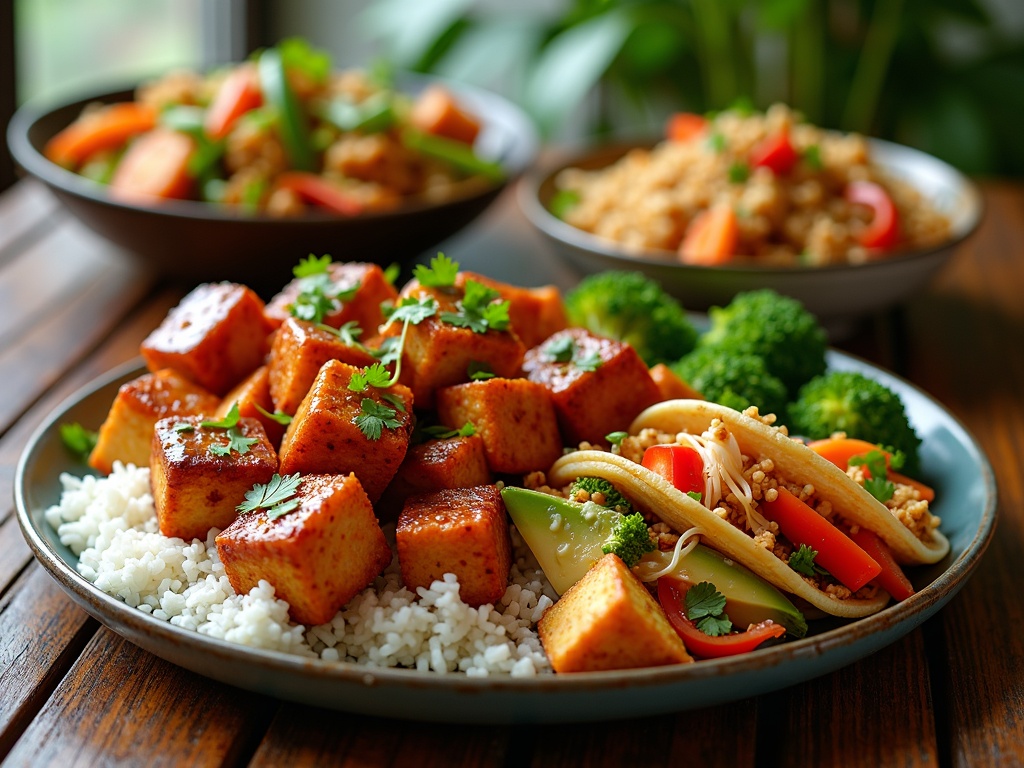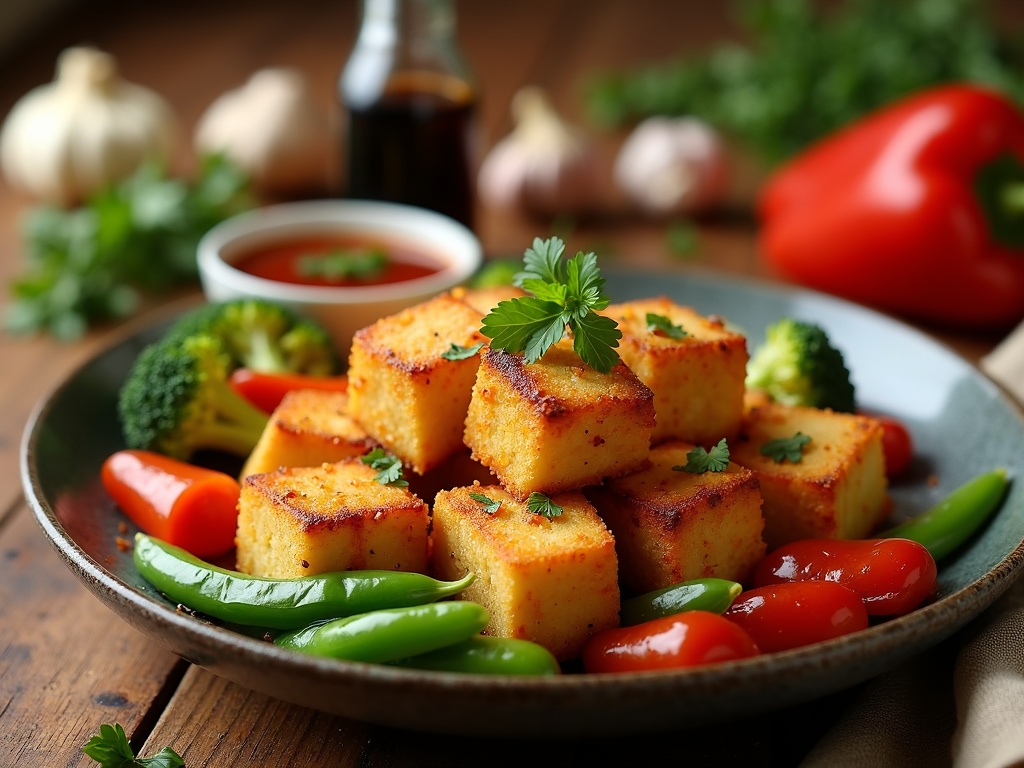Achieving perfectly crispy tofu at home demands just a few essential techniques that transform this versatile plant protein into a delicious culinary staple. Proper pressing, selecting the right tofu type, and using strategic coating methods create restaurant-quality results that adapt to countless flavor profiles and cuisines.
Find In This Article
Key Takeaways
- Press extra-firm tofu for at least 30 minutes to remove excess moisture, which is crucial for achieving a crispy texture.
- Coat tofu lightly with cornstarch or tapioca flour before cooking to create a thin, crispy exterior shell.
- Marinating tofu before cooking (from 15 minutes to 24 hours) significantly enhances flavor absorption.
- Crispy tofu offers impressive nutritional benefits with 8g of protein per 100g serving while remaining low in calories and saturated fat.
- As a sustainable protein choice, tofu requires significantly less water and land to produce compared to animal proteins, making it an environmentally friendly option.
The Ultimate Guide to Perfectly Crispy Tofu
Anyone can make restaurant-quality crispy tofu at home with the right techniques. I’ve spent years perfecting my tofu preparation methods, and I’m excited to share these game-changing tips that transform bland, soggy tofu into crispy, flavorful bites that even skeptics will love.
Master the Press for Perfect Texture
Pressing tofu is non-negotiable for achieving that coveted crispy exterior. When you remove excess moisture, you create space for the tofu to absorb flavors and develop a better texture when cooked. I always press my tofu for at least 30 minutes, though an hour yields even better results.
You have two effective options for pressing:
- Use a dedicated tofu press for consistent, even pressure
- Wrap tofu in paper towels, place between cutting boards, and top with heavy objects (canned goods, cookbooks, or a cast iron pan work great)
The type of tofu you select makes a tremendous difference. Extra-firm tofu contains less moisture from the start and maintains its structure during cooking, making it the ideal choice for crispy preparations. Silken or soft varieties simply won’t achieve the same texture, no matter how long you press them.
Coating and Flavoring for Maximum Crunch
The secret to that irresistible crunch lies in the coating. After pressing and cutting your tofu into your preferred shapes (cubes, slabs, or triangles), I coat it lightly with cornstarch or tapioca flour before cooking. This creates a thin, crispy shell while the interior remains tender.
For the most flavorful results, marinate your tofu before applying the cornstarch coating. A simple yet effective marinade combines:
- Soy sauce or tamari
- Toasted sesame oil
- Minced garlic and ginger
- A touch of sweetener (maple syrup or honey)
Allow your tofu to marinate anywhere from 30 minutes to 24 hours – the longer it soaks, the more flavor it absorbs. If you’re short on time, even a quick 15-minute marinade will improve the taste significantly compared to plain tofu.
After marinating, I pat the tofu pieces gently with paper towels before applying the cornstarch coating. This prevents the coating from becoming gummy and ensures maximum crispy texture. For even more flavor, mix spices directly into your cornstarch – curry powder, nutritional yeast, or smoked paprika are fantastic additions.
When it’s time to cook, make sure your pan or oven is properly preheated. For pan-frying, heat the oil until it shimmers before adding the tofu. For baking in the oven, preheat to at least 400°F (200°C) and use parchment paper to prevent sticking.
The finishing touch for your crispy tofu? A flavorful sauce drizzled on just before serving. This prevents the tofu from becoming soggy while adding another dimension of taste. Try pairing your crispy tofu with a spicy homemade pesto for an unexpected but delicious combination.
With these techniques, you’ll create tofu that’s crispy on the outside, tender on the inside, and packed with flavor – perfect for adding to stir-fries, grain bowls, or enjoying as a protein-packed snack on its own.
Power-Packed Nutrition That’s Good For You
Crispy tofu serves as an excellent protein source in my diet, especially when I need a satisfying meat alternative. With 8g of protein per 100g serving, it provides a substantial amount of this essential macronutrient without weighing me down. I’ve found it particularly valuable for post-workout recovery meals when combined with whole grains and vegetables.
The calorie content makes crispy tofu a smart choice for balanced eating. At just 144 calories per 100g, it delivers impressive nutritional value without excessive energy intake. This makes it perfect for creating satisfying meals that don’t derail my health goals – unlike many other protein sources that can be significantly higher in calories.
A Nutritional Powerhouse for Every Diet
The macronutrient profile of crispy tofu deserves special attention. With only 5g of fat (of which a mere 0.6g is saturated) and 2g of carbohydrates per serving, it fits easily into various eating patterns. I particularly appreciate how this balance allows me to pair crispy tofu with carbohydrate-rich sides like freshly made chapati for a complete meal.
The mineral content stands out as particularly impressive. Each serving provides approximately:
- 350mg of calcium, supporting bone health and muscle function
- 5mg of iron, crucial for oxygen transport and energy production
- Various trace minerals that contribute to overall wellness
For those following vegetarian or vegan diets, crispy tofu offers essential nutrients that might otherwise be challenging to obtain. The complete protein profile includes all nine essential amino acids our bodies can’t produce independently. I often recommend tofu to friends looking for plant-based protein alternatives to traditional chicken dishes.
The protein quality in tofu is comparable to animal sources but comes without cholesterol. This makes it an ideal choice for heart-conscious eating without sacrificing nutrition. When prepared with minimal oil through air-frying or baking techniques, crispy tofu becomes even more aligned with health-focused eating patterns.
Beyond the macronutrients, tofu contains isoflavones – plant compounds with potential health benefits. These naturally occurring phytoestrogens have been studied for their possible roles in supporting hormonal balance and cellular health.
The versatility of crispy tofu extends to its ability to absorb flavors, making it perfect for dishes ranging from stir-fries to pesto-infused creations. This adaptability means I’m never bored while still getting consistent nutrition from this staple.
For athletes and active individuals, the combination of protein with low carbohydrate content makes tofu a valuable addition to training nutrition plans. I’ve incorporated it into my pre-workout meals when I need sustained energy without feeling heavy during exercise.
The fact that tofu requires minimal processing compared to many other protein alternatives gives it an advantage in terms of dietary quality. Unlike highly processed meat substitutes, crispy tofu maintains its nutritional integrity while still delivering satisfying texture and flavor, especially when paired with robust seasonings similar to those used in traditional biryani.
Sustainable Protein for a Better Planet
Making the switch to plant-based proteins like crispy tofu can have a significant positive impact on our planet. I’ve found that incorporating more tofu into my meals not only delivers delicious results but also helps reduce my environmental footprint in several measurable ways.
Resource Efficiency
Land use efficiency stands out as one of tofu’s greatest environmental benefits. Producing just 1kg of tofu requires only 0.4 hectares of land, compared to 0.7 hectares needed for the same amount of beef. This nearly 43% reduction in land use means more space for natural habitats and biodiversity.
Water conservation is another crucial advantage. The water footprint of tofu is remarkably smaller than animal-based proteins. To produce 1kg of tofu requires approximately 2,000 liters of water, while beef demands a staggering 15,000 liters for the same weight. This difference becomes especially important as water scarcity affects more regions globally.
Climate Impact
The climate benefits of choosing tofu are equally impressive. When I’m preparing a crispy protein alternative using tofu, I’m selecting an option that produces just one-tenth of the greenhouse gas emissions compared to beef. This reduced carbon footprint comes from eliminating methane-producing livestock and the energy-intensive processes involved in meat production.
Tofu offers these environmental advantages without sacrificing protein quality. By transforming simple soybeans into versatile tofu, food producers create a complete protein containing all essential amino acids our bodies need.
I’ve noticed more restaurants and food brands highlighting the sustainability credentials of their tofu dishes. This shift reflects growing consumer awareness about the connection between food choices and environmental impact. When properly prepared with the right seasonings and cooking techniques, crispy tofu delivers satisfying texture and flavor while supporting planetary health.
For anyone looking to reduce their environmental footprint without compromising on taste or nutrition, tofu represents an excellent choice. Its production efficiency, from land use to water conservation to reduced emissions, makes it a truly sustainable protein for our increasingly resource-constrained world.

Heart-Healthy Benefits and Weight Management
I’m a huge fan of crispy tofu not just for its amazing texture and taste but also for its impressive health benefits. This versatile soy product offers numerous advantages for heart health and weight management that make it worth adding to your meal rotation.
Crispy tofu makes an excellent protein choice if you’re looking to manage your weight. With approximately 8 grams of protein per 100-gram serving, it provides substantial satiety without excessive calories. The protein content helps keep hunger at bay between meals, which can prevent overeating and support weight maintenance goals. I’ve found that replacing higher-calorie protein sources with tofu can create a calorie deficit without sacrificing nutrition or feeling deprived.
What’s particularly impressive about tofu is its positive impact on heart health. The soy protein in tofu has been shown to help reduce LDL cholesterol (often called “bad” cholesterol). Adding crispy tofu to your diet a few times a week can be part of a heart-healthy eating pattern. The plant compounds in soy, particularly isoflavones, may also help improve overall cardiovascular health when consumed regularly.
Nutritional Powerhouse for Various Diets
Tofu’s versatility makes it a nutritional superstar across many dietary patterns. Here’s why it deserves a spot in your meal planning:
- Low in saturated fat yet high in essential nutrients like calcium, iron, and manganese
- Contains all nine essential amino acids, making it a complete protein source
- Provides beneficial phytoestrogens that may offer additional health benefits
- Offers a good source of omega-3 fatty acids, particularly alpha-linolenic acid
- Contains no cholesterol, unlike animal protein sources
- Provides essential minerals including selenium, phosphorus, copper, and zinc
I’ve discovered that crispy tofu serves as an essential plant-based protein for muscle maintenance. Whether you’re following a vegetarian, vegan, or flexitarian diet, tofu provides the amino acids necessary for muscle protein synthesis and recovery. This makes it particularly valuable for active individuals looking to maintain or build lean muscle mass while managing their weight.
The beauty of crispy tofu lies in its culinary flexibility. I can incorporate it into nearly any cuisine type—from Asian-inspired stir-fries with crispy texture to Mediterranean dishes, Mexican-inspired bowls, or even as a protein addition to salads. This adaptability means you’re less likely to get bored with your healthy eating plan, which improves long-term adherence.
For those transitioning to more plant-based eating, crispy tofu offers a satisfying texture that can help ease the shift away from meat. The firm, crispy exterior combined with a tender interior provides a delightful mouthfeel that satisfies various texture preferences. When properly prepared, it absorbs flavors beautifully while maintaining its structure, making it perfect for rich, flavorful sauces and marinades.
Beyond weight management and heart health, tofu contains compounds that may offer additional health benefits, including potential protection against certain cancers and improved bone health in some populations. The isoflavones in soy may also help reduce menopausal symptoms in some women.
I recommend experimenting with different cooking methods to achieve the perfect crispy texture. Air frying, baking with cornstarch, or pan-frying with minimal oil can all yield excellent results without adding excessive calories. The key is removing excess moisture before cooking – press your tofu between paper towels with a heavy object for at least 30 minutes for best results.
For a complete meal, pair your crispy tofu with fiber-rich vegetables and complex carbohydrates like whole grain chapati or brown rice. This combination provides sustained energy while supporting your weight management and heart health goals.

Must-Try Crispy Tofu Recipes
Crispy tofu has become my go-to protein source when I want something versatile, nutritious, and absolutely delicious. After perfecting the basic technique for getting that perfect exterior crunch, I’ve discovered some fantastic recipes that showcase just how adaptable this plant-based protein can be. From Asian-inspired dishes to Mexican fusion creations, crispy tofu works brilliantly across various cuisines.
Asian-Inspired Crispy Tofu Dishes
General Tso’s Tofu transforms the humble soybean curd into something extraordinary. I start by coating extra-firm tofu cubes in cornstarch before frying them until golden. The magic happens when these crispy nuggets meet a sweet-spicy sauce made with soy sauce, rice vinegar, brown sugar, garlic, ginger, and dried chilies. The sauce coats each piece perfectly, creating a glossy finish that’s irresistible. I often serve this over steamed rice with a side of broccoli for a complete meal.
For busy weeknights, I rely on a quick vegetable stir-fry with crispy tofu. After frying the tofu until golden, I set it aside and quickly sauté bell peppers, snap peas, carrots, and broccoli. The crispy protein pairs wonderfully with these colorful vegetables. The soy-based sauce I use combines tamari, sesame oil, rice vinegar, and a touch of maple syrup, creating a perfect balance of savory and sweet flavors that bring the dish together.
Creative Fusion Recipes
Crispy tofu tacos have become a favorite in my household. I cut the tofu into thin slabs and season them with cumin, paprika, garlic powder, and a touch of lime zest before frying. Once crispy, I stuff them into warm corn tortillas and top with a vibrant mix of fresh ingredients – shredded cabbage, diced avocado, cilantro, and a squeeze of lime juice. For an extra kick, I add a drizzle of sriracha mayo. These tacos offer an exciting twist on traditional fillings and satisfy even dedicated meat-eaters.
Looking for ways to add protein to your salads? Crispy tofu makes an exceptional salad topper that adds both nutrition and texture. I dice the tofu into small cubes, coat them in cornstarch mixed with nutritional yeast for a cheesy flavor, then fry until golden brown. These crunchy morsels transform ordinary salads into protein-rich meals that keep me satisfied for hours. They work particularly well on grain bowls with quinoa, roasted vegetables, and a tahini dressing.
The versatility of crispy tofu extends beyond these recipes. I’ve used it in Buddha bowls, stuffed into sandwiches with fresh vegetables, and even added to breakfast scrambles for a protein boost. The key to success with any crispy tofu recipe lies in proper preparation – pressing out excess moisture, using the right coating, and frying at the correct temperature.
These recipes have helped me incorporate more plant-based meals into my diet without sacrificing flavor or satisfaction. The wonderful thing about crispy tofu is how it takes on the flavors of whatever seasoning or sauce you pair it with, making it endlessly customizable for different taste preferences and culinary inspirations from around the world.

Sources:
Vegetarian Times – “Nutritional Comparison of Tofu and Other Protein Sources”
Food & Agriculture Organization of the United Nations, 2021 – “Environmental Impact of Tofu Production”
Healthline – “The Health Benefits of Tofu”
Bon Appétit – “Crispy Tofu Recipes”
Serious Eats – “Tofu Pressing Techniques”

